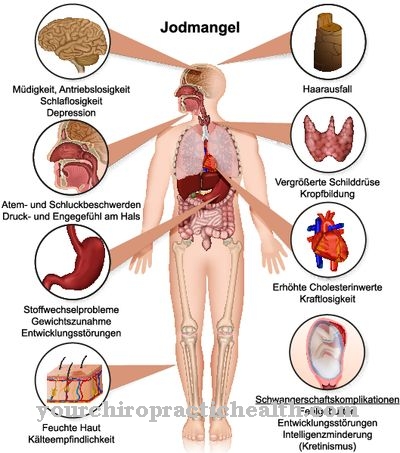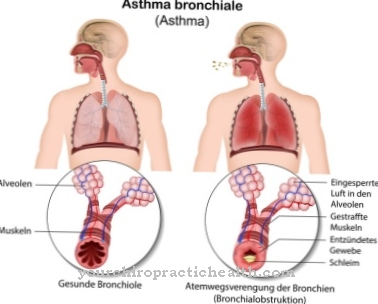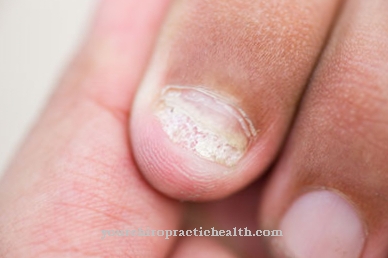Of the Broken jaw occurs in more than half of all fractures that affect the skull. For this reason, the broken jaw is considered to be one of the most common breaks on the head.
What is a broken jaw?

© PATTARAWIT - stock.adobe.com
Of the Broken jaw can appear in two different dimensions and be located on both the upper and lower jaw. If there is a broken jaw, the bone has been destroyed so that the broken jaw is one of the fractures. Depending on where the broken jaw is located, it is either an upper or lower jaw fracture.
Both diagnoses require appropriate treatment in order to restore normal function to the jaw with the teeth embedded in it. In individual cases, however, the jaw fracture is so extensive and complex that it takes an extremely long time until its physiology is completely restored and the jaw is resilient.
causes
The causes for one Broken jaw are usually based on the sudden application of mechanical forces, which lead to a fracture of the bones.
In the case of a broken jaw on the upper jaw, it is usually so-called blunt force effects. These usually hit the rather thin bones with a high energetic potential. A fracture of the upper jaw is a consequence of traffic accidents as well as intensive physical assaults.
In addition, a broken jaw can also occur on the lower jaw as a result of bullets penetrating the body or as a result of explosive projectiles and after falling on the head. Accidents during sporting activity as well as the effects of force from animals (hooves on kicking horses) also quite often cause a broken jaw.
Symptoms, ailments & signs
A broken jaw initially manifests itself as jaw pain. The pain occurs mainly when chewing and speaking and is often described by those affected as stabbing or pressing. Associated with this is a restricted mobility of the jaw. A misaligned jaw can lead to a misaligned teeth in which the teeth no longer fit together properly.
Often the teeth are loose or even fall out. Persistent numbness may occur in the lower lip area. Bleeding into the floor of the mouth is also possible. In severe injuries, bleeding occurs in addition to the broken jaw. The lips, chin and nose are usually affected. Injuries to the tongue and the cheek pockets are also possible.
The visible misalignment of the jaw is the most obvious external feature. In addition, a broken jaw can be recognized based on any deformations and bleeding. A tooth misalignment indicates a previous fracture of the jaw. The symptoms of a broken jaw subside after a few days to weeks. If surgical treatment is carried out at an early stage, any misalignment of the jaw can also be corrected without any long-term consequences. With appropriate treatment, the pain subsides after a few hours.
Diagnosis & course
When making a diagnosis with the aim of finding a Broken jaw To recognize both its extent and its localization, the specialists use various methods. The patient's statement serves as the primary clue. However, if this cannot be addressed, a visual assessment of the jaw is carried out first.
It is difficult to make a clear diagnosis of a broken jaw. The final results that confirm a broken jaw are largely based on the inclusion of technical equipment, which includes x-ray devices. In addition to checking the mobility in the event of a broken jaw and the triggering of pain, doctors can also perform a computed tomography if the findings are unclear.
Depending on where the broken jaw is located, either abnormal movements occur or noticeable swelling on the face can be seen. When diagnosing and developing a broken jaw, it is always a complex of several anomalies, in which the eye sockets must also be inspected.
Complications
A broken jaw is a clinical picture that should be treated by a doctor. Otherwise there is a risk of serious consequential damage from which those affected can no longer fully recover. According to this, such a broken jaw is also associated with various complications that should always be treated by an appropriate doctor.
If a broken jaw is left without any treatment, the fracture will not grow together on its own. Of course, there is also extremely severe pain, which can also only be removed by a surgical procedure. If you do not have an operation at this point, you must of course expect considerable complications. The fracture may even have an abscess, so there is a risk of blood poisoning.
Of course, this complication must also be treated by a doctor, otherwise there is an acute danger to life. Existing bacteria and viruses can also spread throughout the body through such an abscess, causing an infection. Those who leave such an infection without treatment are of course also running a great risk. Headache, fever and sore throat can occur, so that treatment by a doctor is necessary here too.
When should you go to the doctor?
If severe pain in the mouth area occurs after a fall, accident or exposure to violence, a doctor's visit is required. If the jaw can no longer be moved as usual or if there are irregularities in the chewing process, a doctor is required. Visual changes in the shape of the face, discoloration of the skin around the chin or deformities in the upper neck indicate irregularities that need to be examined and treated. A restriction in vocalisation, difficulty swallowing and problems opening the mouth are signs of a health problem.
A doctor's visit is necessary so that medical care can be initiated immediately. If the supply of food and drinks is refused, the person concerned needs a doctor. If the symptoms persist for several hours or if the symptoms increase, a doctor should be consulted. Anxiety, sweating, tremors, and discomfort with an existing denture are conditions that should be monitored. If there is a loss of blood or vomiting of blood, a doctor must be consulted.
In the event of a breakdown in the circuit, an ambulance service must be alerted. At the same time, first aid measures must be taken by those present. If children show sudden changes in behavior by screaming and crying unabated over a long period of time, they should be presented to a doctor as soon as possible.
Treatment & Therapy
As part of the possible therapy for a Broken jaw there is usually an initial treatment of the fracture. Further treatments follow after intensive differential diagnosis. In the case of a broken jaw, these are based on surgery, repositioning and fixation.
During the initial treatment, which is usually provided as an accident care, improved breathing is made possible. In some cases, the obstruction of the airway in the case of a broken jaw may require intubation. A temporary splint of the upper or lower jaw as well as emergency pain treatment follow in the case of a broken jaw.
Surgical intervention for a broken jaw involves aesthetic restoration. In this context, it can be the case that in the case of a broken jaw, individual splintered bone parts have to be connected to one another and their fixation on the skull bone is necessary. During intubation, ventilation is mainly provided through the nose.
If the jaw fracture is extremely extensive, ventilation can be carried out using a tube through the opened floor of the mouth. In order to obtain an exact reconstruction of the healthy jaw in the event of a broken jaw, the bone parts are placed in their natural anatomical locations as part of a reduction. The treatment of a broken jaw is accompanied by long-term immobilization and possible compression on the fracture site.
Pain relievers and anti-inflammatory drugs are said to promote better healing. The pain medication also helps to relieve permanent, severe headaches.
You can find your medication here
➔ Toothache medicationOutlook & forecast
A broken jaw can usually be healed if medical care is sought immediately after the triggering event. Otherwise, there is a risk of permanent damage and severe impairment of quality of life. The break will not grow together on its own without medical help. There is severe pain and the risk of complications is significantly increased.
The chewing process is significantly impaired and speaking is significantly more difficult. Viruses and bacteria can lodge and spread in the mouth and throat area. In severe cases, the affected person is at risk of shortness of breath or blood poisoning. Sepsis means an immediate threat to life. Disorders of the respiratory tract can also lead to a fatal course of the disease.
With one treatment there is a comprehensive control of the damage suffered. In difficult cases, an operation is carried out immediately to save the life of the person concerned. The jaw is immobilized so that the best possible healing can take place. Under optimal conditions, the patient receives a splint after a few weeks or months, which ensures the stability of the jaw during the further course of the recovery process. For some people, additional surgical interventions are carried out for aesthetic reasons. Split bone parts must be connected to one another and permanently fixed to the skull bone.
prevention
To one Broken jaw To prevent this, it is particularly important to prevent mechanical impact on this area. In addition, it is unavoidable to wear a chin guard when taking precautions against accidents in order to cushion or absorb impacts or blows.
Aftercare
Follow-up care aims, among other things, to prevent the recurrence of an illness through regular follow-up examinations. However, this goal cannot be implemented for a broken jaw. The typical complaints are caused by external forces such as falls or blows. They happen purely randomly and selectively.
Unlike a tumor, a doctor cannot detect a future fall or blow to the jaw in the early stages. As a result, follow-up care after recovery is of no importance. Medical care ensures that no complications arise in the healing process. However, it is unable to prevent a new jaw fracture.
If a new fracture occurs, the doctor tries to support the patient in his daily routine as in the previous treatment. The patient has to rest for six weeks. Food can only be consumed in liquid form. Since oral hygiene cannot be carried out in everyday life, the person affected has to avoid foods that contain sugar.
The progress of the healing is checked in regular examinations. Imaging methods such as X-rays or CT are suitable for this. The jaw is then fully resilient again. There is no need for further medical examinations.
You can do that yourself
If a broken jaw is suspected, cool down and take care of yourself first. Until the emergency doctor arrives, the jaw must be treated with a cold pack and immobilized. If it is an open break, it must be covered immediately with sterile wound dressings. In the event of a shock, the person affected should be placed on their side in a stable position - then calm down and repeatedly check awareness and breathing. The ambulance doctor must be informed immediately about the circumstances of the broken jaw.
Bed rest is recommended after the initial treatment. The jaw must be spared for a few weeks. In order to lose as little weight as possible during this time, a change in diet is necessary. At the beginning only liquid food can be consumed - soups and teas, pureed dishes and sippy food from the pharmacy cover the calorie requirement sufficiently. At the same time, oral hygiene must also be adjusted. Special hygienic rinses from the drugstore are just as useful as natural home remedies (e.g. tea tree oil or aloe vera) and curved toothbrushes.
Finally, the jaw muscles should be strengthened through regular exercise. Especially with larger fractures, it is important to practice chewing daily so that no symptoms occur after recovery.



























